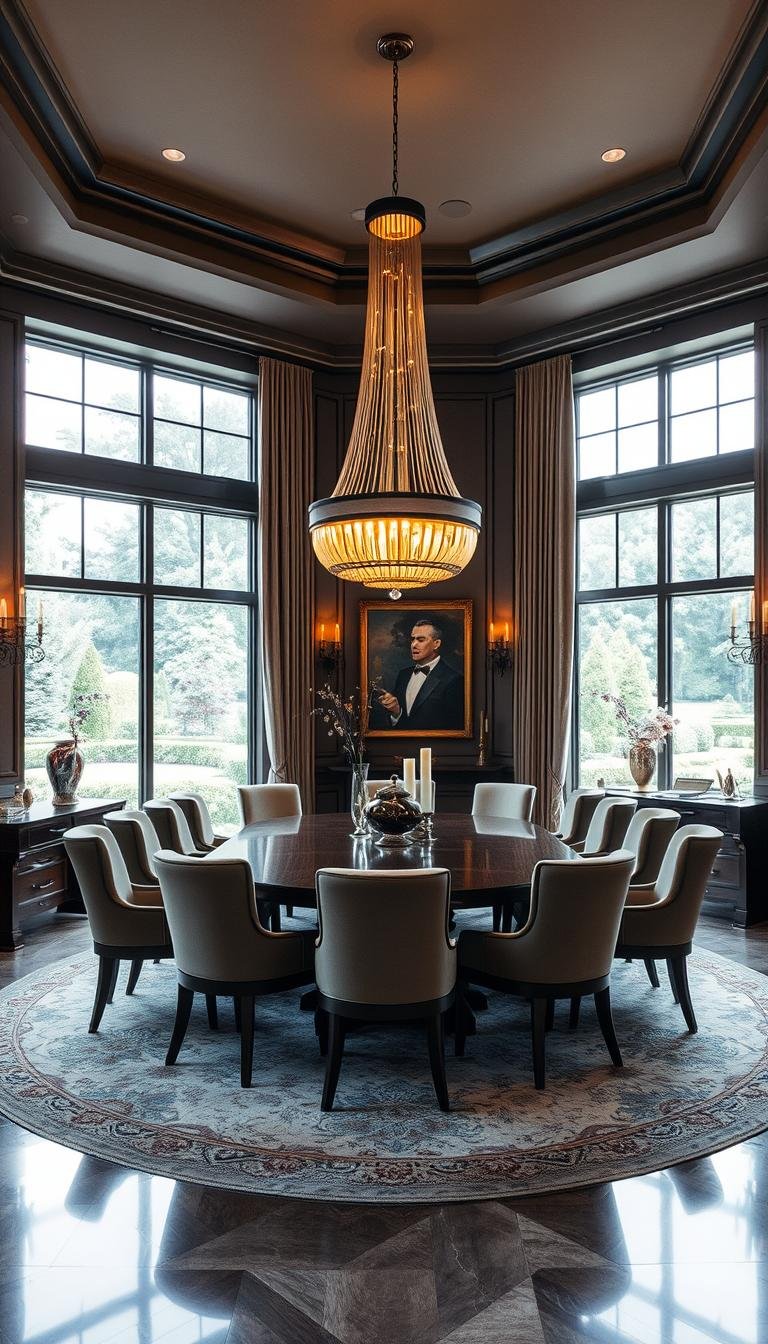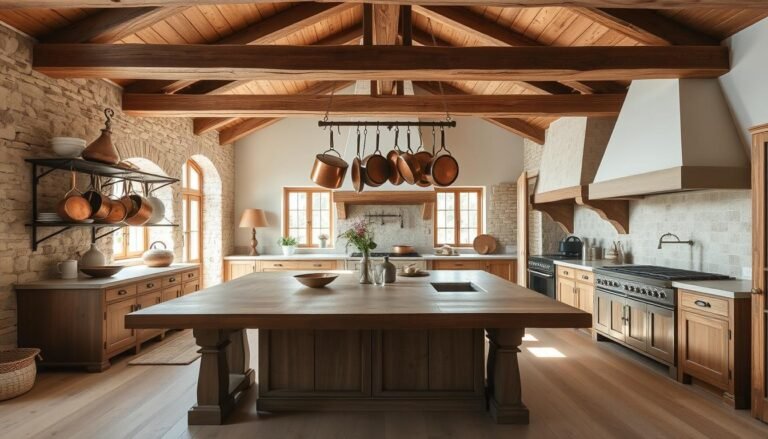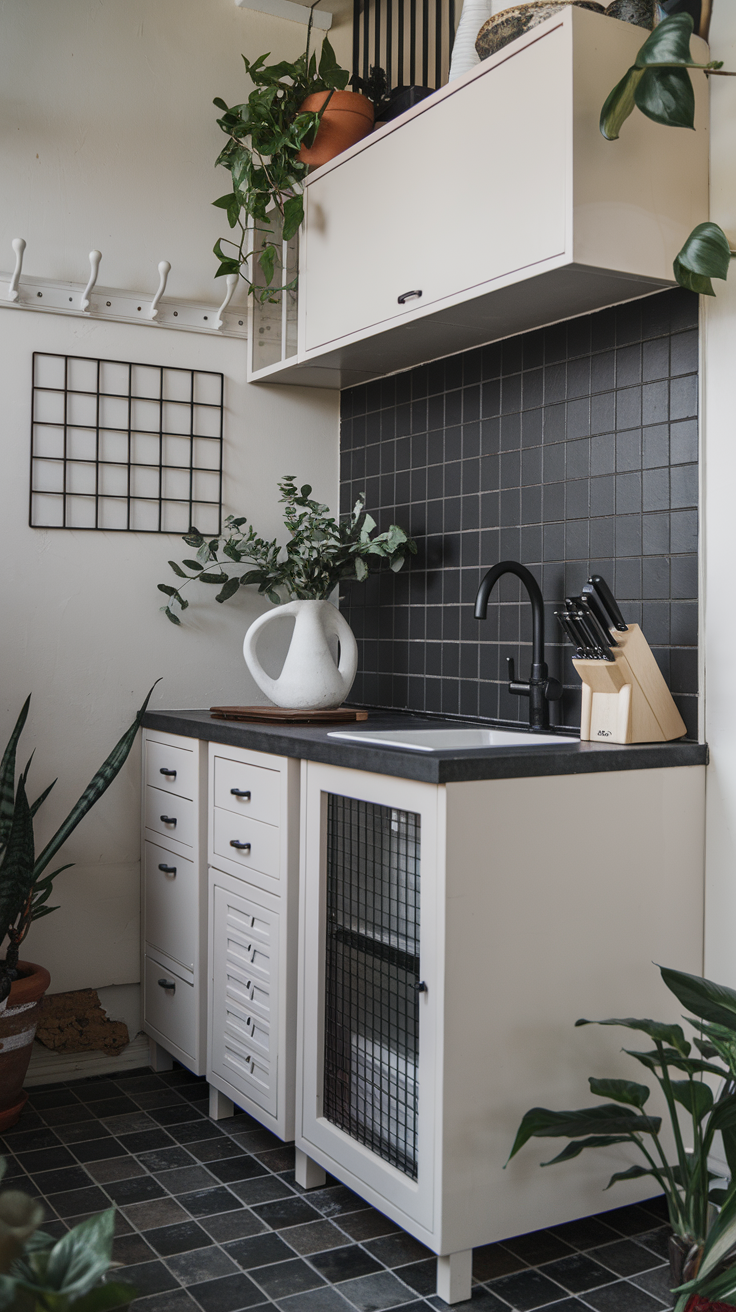Stylish Dining Room Decor: Elevate Your Space
Did you know 78% of homeowners say refreshing their gathering space sparks more joy than any other home project? (Yep, even beating out kitchen remodels!) Whether you’re hosting Thanksgiving dinner or weekly taco nights, this spot isn’t just about meals—it’s where memories get made.
I’ve noticed something cool: even in our “open concept” era, folks still crave a dedicated area that feels special. Take it from designer Laurey W. Glenn, who told me, “Your table isn’t just furniture—it’s the stage for life’s big moments.” That’s why we’re digging into pro tips from folks like Stephanie Sabbe, who turns basic spaces into showstoppers with smart lighting and textured linens.
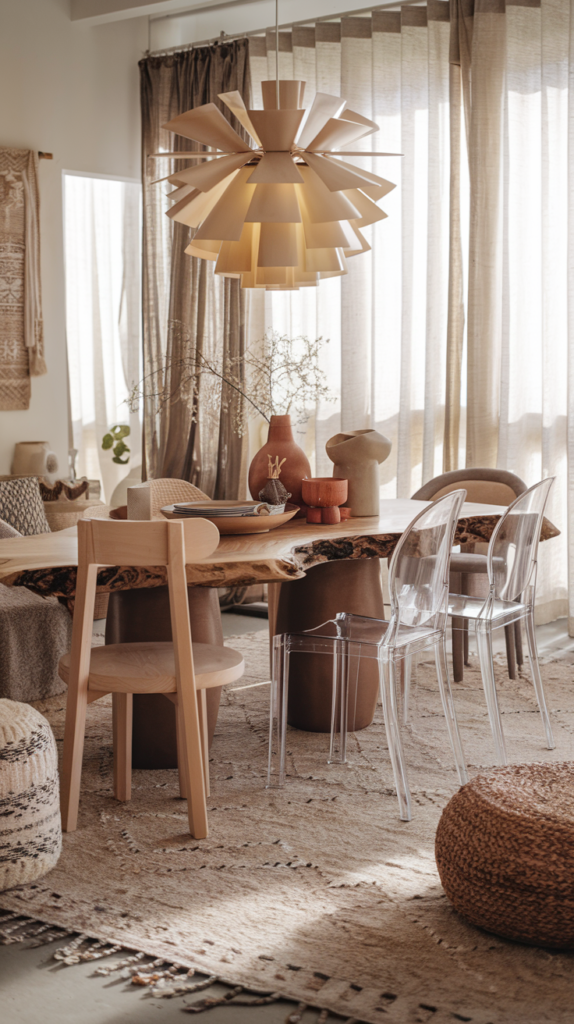
Here’s the best part: you don’t need a mansion-sized budget. We’ll walk through wallet-friendly hacks (hello, thrifted centerpieces!) alongside luxe designer moves. Ready to create a space that works for Tuesday night homework sessions and Saturday dinner parties? Let’s roll up our sleeves.
Key Takeaways
- Your gathering space remains a timeless hub for connection and celebration
- Top designers blend functionality with personality-driven details
- Lighting and textiles dramatically transform atmosphere
- Budget-friendly updates can make big visual impacts
- Personal touches create spaces that feel authentically yours
Understanding the Allure of Dining Room Decor
Ever notice how some spaces just pull people in like magnets? That’s the magic of a well-designed dining area—it’s not just where you eat, but where game nights turn legendary and deep talks flow with dessert. I’ve seen clients use these zones as makeshift offices by day and candlelit dinner spots by night. Talk about multitasking!
What makes these spaces stand out? Unlike the living room (which usually says “sit and stay awhile”), a great eating zone whispers, “Let’s connect.” Designer Athena Calderone nailed it when she transformed a Brooklyn loft’s dining area into an art gallery-meets-supper-club hybrid. Her secret? Mixing sculptural chairs with a raw-edge table that says “casual elegance.”
Here’s the kicker: your dining space can wear multiple hats without losing its charm. Try these pro-approved moves:
- Bench seating that tucks under tables for space-saving flexibility
- Statement lighting that doubles as art when the room’s not in use
- Layered rugs defining zones in open-concept layouts
I once helped a family turn their underused dining area into a puzzle station by adding hidden storage under the table. Now their Friday nights involve pepperoni pizza and 1,000-piece jigsaws. Proof that when form meets function, magic happens.
Essential Dining room decor ideas That Transform Your Space
What’s the secret sauce that turns blah spaces into “wow” zones? It’s all about nailing your foundation pieces. I’ve seen a reclaimed wormy chestnut dining table become the heart of a home—its knots and grooves telling stories better than any coffee table book. Pair it with buttery faux leather chairs, and suddenly Tuesday meatloaf tastes like a Michelin-star meal.
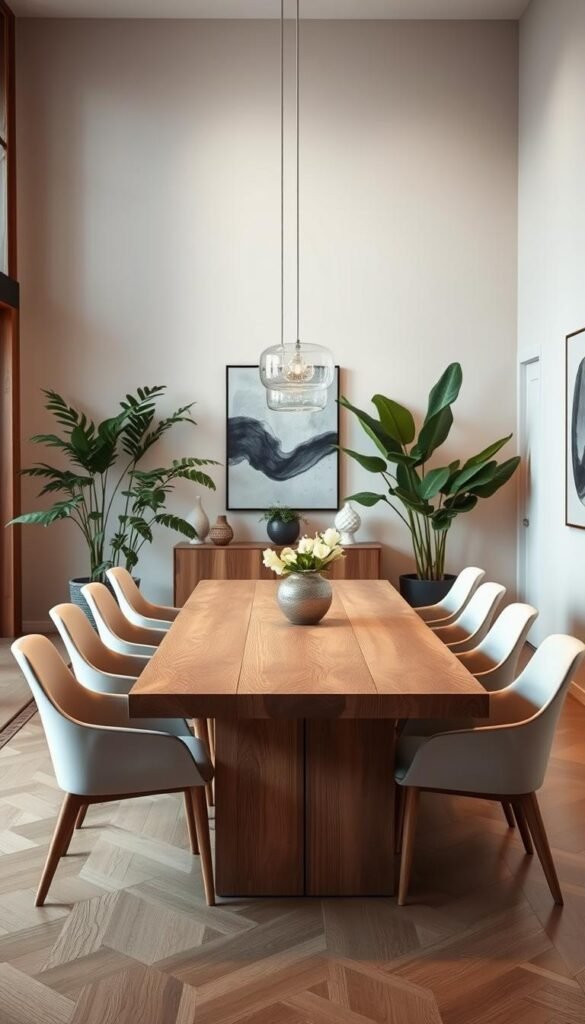
Here’s my golden rule: your table sets the tone, while chairs bring the personality. Take a page from designer dining rooms that mix industrial metal stools with farmhouse trestle bases. The trick? Keep one element consistent—like matching wood tones or repeating curved lines.
Three game-changing combos I’m loving:
- Live-edge slab tables with transparent acrylic chairs (hello, floating effect!)
- Glossy oval tops paired with woven banana leaf seats
- Vintage parsons tables flanked by plush velvet armchairs
Durability matters more than you’d think. A client’s spill-proof dining chairs survived three kids’ mac-and-cheese years while still looking Instagram-ready. Pro tip: test furniture weight limits by sitting cross-legged—if it wobbles, keep shopping.
Last week, I spotted a couple using their sculptural concrete table as an art display when not in use. Genius! Your foundation pieces should work as hard as you do—beautifully.
Trendsetting Designer Inspirations for 2025
What if your eating area could predict the future? I’ve been geeking out over 2025’s designer forecasts, and let me tell you—the pros are tossing rulebooks out windows. Buffy Hargett Miller recently hung a neon chandelier shaped like dandelion fluff above a client’s table. Stephanie Sabbe? She painted a wall-to-wall floral mural that glows under smart lighting. These aren’t just rooms—they’re mood boards for tomorrow.
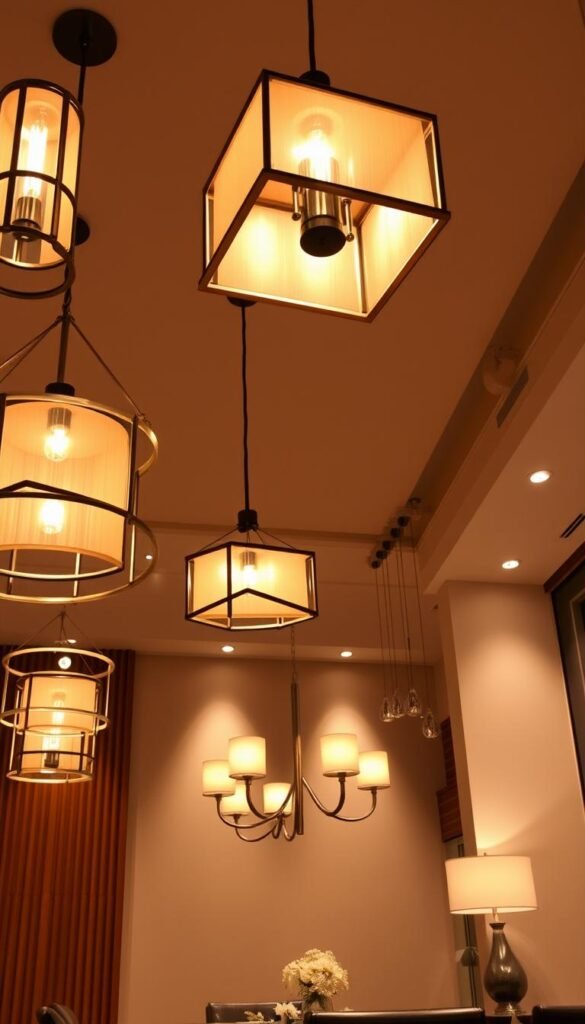
Innovative Styles from Top Designers
The magic happens when old-school charm crashes into futuristic flair. I’m seeing designers pair heirloom sideboards with tables made from recycled aircraft aluminum. One client mixed her grandma’s china cabinet with lucite chairs that look like ice sculptures. “It’s like time travel with better snacks,” she joked.
Three fearless choices trending now:
- Ceiling-mounted planters doubling as light fixtures
- Hand-painted tiles mimicking digital glitch art
- Tables with built-in charging stations disguised as colorblock patterns
Bold and Colorful Trends to Watch
Remember when beige was safe? 2025’s color palettes scream confidence. Think emerald green walls meeting terracotta ceilings. I tried this combo last month—paired with brass pendant lights, it felt like dining inside a jewelry box. Pro tip: test bold hues first. A client painted one wall electric violet before committing—now it’s her Zoom background.
Lighting’s getting cheeky too. That sculptural piece above? It’s actually a sound-responsive installation that dims when you clap. Design isn’t just what you see—it’s what your space does. Ready to play?
Lighting Magic: Choosing the Perfect Fixture
Picture this: you’re about to serve the perfect meal, but something feels off. The culprit? Harsh overhead glare that makes your pasta look like cafeteria food. Lighting isn’t just functional—it’s mood-altering magic. I’ve seen clients swap cold LEDs for warm dimmers and suddenly their Friday pizza nights feel like date nights.
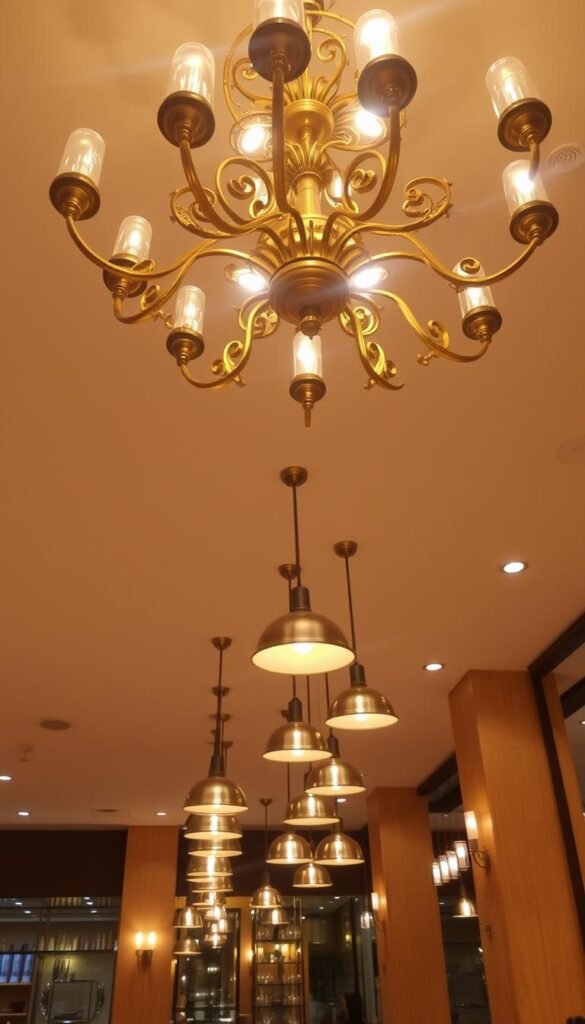
Chandeliers, Pendant Lights, and More
Let’s break down your options. A Nashville designer recently hung a chandelier made of 200 hand-blown glass orbs in a 20-foot foyer—it now casts rainbow prisms across the seating area at sunset. Meanwhile, pendant lights over a kitchen peninsula can multitask: task lighting for meal prep, ambient glow for wine tastings.
Scale matters most in tall spaces. That shell fixture you love? It needs breathing room. Designers often use this trick: add the length and width of your space (in feet), convert to inches—that’s your ideal light diameter. For standard 8-foot ceilings? Keep fixtures 30-34 inches above the table.
Three rules I live by:
- Layer lighting like you layer outfits—overhead + wall sconces + candles
- Match metal finishes to seating legs or hardware for cohesion
- Use plug-in swag kits to fake built-in fixtures (your secret’s safe with me)
Last month, I helped a family transform their kitchen-adjacent nook. We installed adjustable pendants that brighten for homework sessions and dim for taco nights. The kicker? They found the fixtures on Facebook Marketplace for $75 each. Proof that good lighting doesn’t need to break the bank—just your old assumptions.
Color and Texture: Setting the Mood in Your Dining Room
Have you ever walked into a space that instantly made you feel calm or energized? That’s the power of color psychology at work. Your four walls aren’t just boundaries—they’re mood-setting machines. I recently helped a client transform their bland eating nook by painting the ceiling midnight blue. Now their family jokes it feels like dining under the stars.
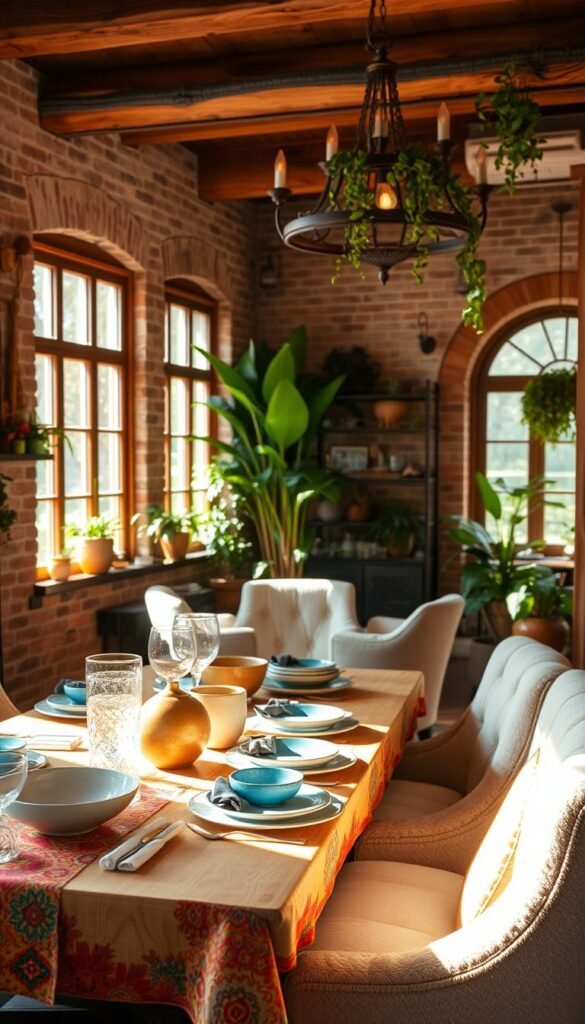
Let’s talk walls. That grasscloth wallpaper you’ve been eyeing? It adds subtle texture without shouting for attention. But if you’re feeling bold, try oversized floral patterns. One designer draped an entire wall in peel-and-stick wallpaper mimicking vintage botanical prints. “It’s like bringing the garden indoors,” she told me.
Pro tip: Use paint to fake architectural drama. Highlight awkward niches with contrasting hues or extend wall colors onto trim for a modern twist. My go-to move? Painting window frames the same shade as walls—it makes spaces feel taller.
Here’s how to layer like the pros:
- Pair matte walls with glossy moldings
- Mix velvet cushions with rough linen runners
- Anchor bold color combos with neutral floors
Last month, I saw a navy accent wall play nice with blush chairs and brass sconces. Proof that soft and bold can tango beautifully. Remember: your walls should do the heavy lifting so your furniture can shine.
Mixing Modern and Vintage: Creating Eclectic Dining Spaces
Imagine your great-grandma’s farm table surrounded by sleek acrylic chairs—sounds wild, right? That’s the beauty of blending eras. I helped a couple revive a 1920s oak table by pairing it with transparent ghost chairs. The result? A space that feels both nostalgic and fresh, like a vinyl record spinning in a smart home.
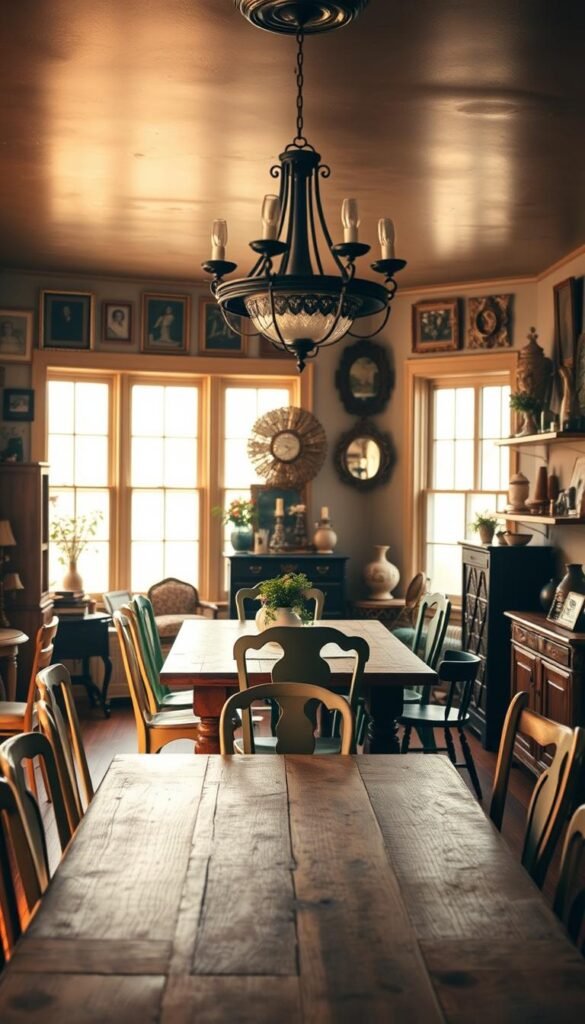
Integrating Antique Pieces with Contemporary Flair
Here’s the secret: treat vintage finds like rockstars, not relics. Designer Sarah Sherman Samuel recently styled a client’s 1950s sideboard with geometric sconces and a neon clock. “It’s about creating visual conversations between pieces,” she told me. That chippy paint? Let it shine against crisp white walls.
Three rules I swear by:
- Anchor with one wood statement piece (reclaimed tables work magic)
- Mix metals intentionally—brass candlesticks next to chrome lamps
- Use textiles to bridge styles (a faded Persian rug under modern chairs)
Last month, I found a client’s home overflowing with heirlooms. We edited down to her grandmother’s china cabinet and paired it with a concrete-topped island. Now her morning coffee tastes like history meets hustle. Pro tip: Repeat colors across eras. Those vintage green plates? Match them to modern napkins for instant cohesion.
Remember: decorating isn’t about perfection. That scratch on your thrifted chairs? It’s proof your space has stories to tell. Now go make some new ones.
Maximizing Space in Compact Dining Areas
Who says small spaces can’t host big gatherings? I recently worked with a couple in Brooklyn whose eating zone was smaller than a parking spot. Their secret? Treating every inch like real estate gold. We installed a banquette that hugs the wall with hidden drawers for table linens—suddenly, their 8×10 area seats six comfortably.
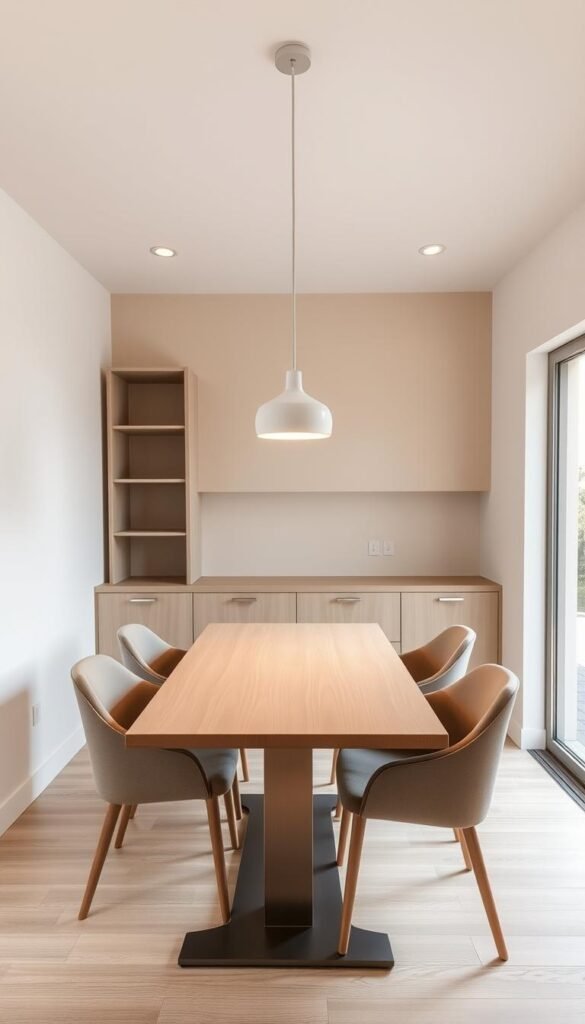
Built-In Storage and Corner Solutions
Let’s talk vertical real estate. That awkward corner by the window? Perfect for a triangular shelving unit that displays plants and stores wine glasses. I’ve seen clients add flip-up tables to unused wall sections—fold it down for brunch, flip it up for floor space.
Three space-saving wins I love:
- Banquettes with lift-up seats (hello, holiday dish storage!)
- Nesting tables that tuck under main tables when not in use
- Ceiling-mounted pot racks doubling as art installations
Last month, a family transformed their narrow breakfast nook using a bench that slides under a floating table. Now their toddler’s art supplies live underneath, and cleanup takes 30 seconds. Pro tip: Use mirrored backsplashes to visually expand tight spaces—it’s like optical illusion magic for your walls.
Remember: small areas thrive on duality. That storage ottoman? It’s extra seating during dinner parties. Your corner cabinet? A bar cart in disguise. When every piece pulls double duty, your compact zone becomes the ultimate multitasker.
Multifunctional Dining Areas: Combining Work, Living, and Dining
What if your table could moonlight as your office by day and host dinner parties by night? I’ve watched this trend explode—especially in cozy bungalows where every square foot needs to hustle. Last month, I helped a client transform their underused area into a work-play hub using a built-in desk that folds down into a buffet table. “Now I grade papers here by morning and serve tapas by evening,” she told me. Genius, right?
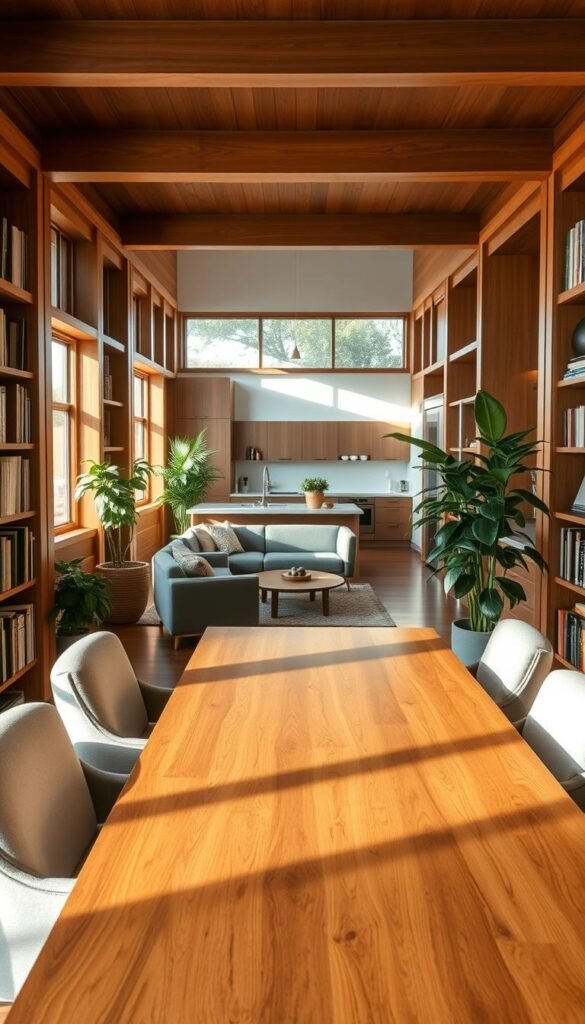
Flexible Layouts for Connected Spaces
Designer Becki Owens nails it: “Your living zones should flow like good conversation.” I love using mobile islands on casters—they roll between rooms as needed. A family in Austin uses theirs as a coffee station during meetings and a dessert cart when guests arrive. The secret? Keep pathways clear. Leave 36 inches around furniture for easy transitions.
Three rules for hybrid spaces that work:
- Choose lightweight chairs you can stack or tuck under tables
- Install plug-in wall sconces to free up surface space
- Use rugs to define zones without permanent walls
I recently saw a loft where the area between the kitchen and lounge holds a expandable table. It seats four for weekday meals but stretches to ten for game nights. Bonus: the owner hung floating shelves above it to store both cookbooks and board games. Proof that smart living spaces adapt faster than a chameleon at a rainbow convention.
Art and Accessory Highlights in Dining Room Decor
Ever walked into a space where the walls practically tell stories? That’s the power of intentional art and accents. I’ll never forget a Nashville client’s home where a bold abstract painting stopped guests mid-sentence—suddenly everyone was debating whether it resembled storm clouds or marble swirls. Turns out, great design sparks dialogue before the first course arrives.
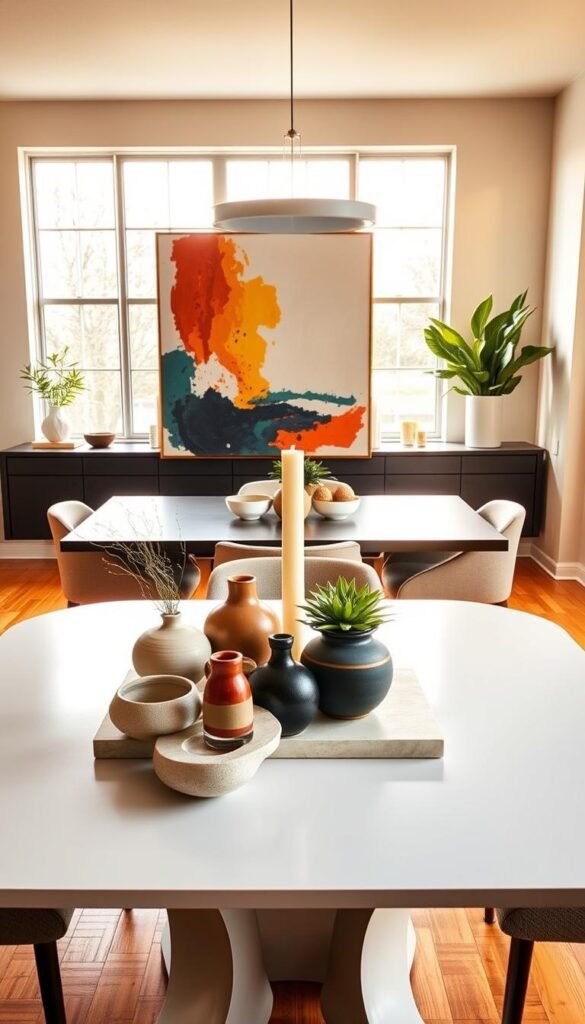
Focal Points That Spark Conversation
Your look starts with one showstopper piece. Think beyond traditional paintings—I’ve seen everything from vintage surfboards to handwoven tapestries anchor spaces. A Houston designer hung floating shelves with mismatched ceramic vases above a table. “Guests can’t resist asking about each piece’s origin story,” she told me. Pro tip: Position your art at eye level when seated—about 48 inches from the floor.
Accessories should add touch without clutter. Try these subtle moves:
- Textured napkin rings that feel as good as they look
- Hand-blown glass pitchers catching light from windows
- Unexpected book stacks serving as risers for centerpieces
Last month, I helped style a loft where the client’s collection of vintage lunchboxes became the look along a floating shelf. Now guests reminisce about their childhood thermoses while passing the potatoes. The secret? Let your personality shine through pieces that invite touch and interaction.
Balance is key. Those dramatic floral plates? Pair them with simple linen runners. A client’s neon sign reading “Eat More Tacos” works because it’s balanced by neutral windows treatments. Remember: your accents should harmonize like instruments in a band—each playing distinct notes that create one beautiful melody.
Statement Furniture and Unique Seating Arrangements
Your chairs might be the unsung heroes of your home. I recently helped a family transform their basic setup using a live-edge walnut table flanked by velvet barrel seats. The result? A space that feels equal parts cozy supper club and art studio. Their secret? Treating furniture like functional sculpture.
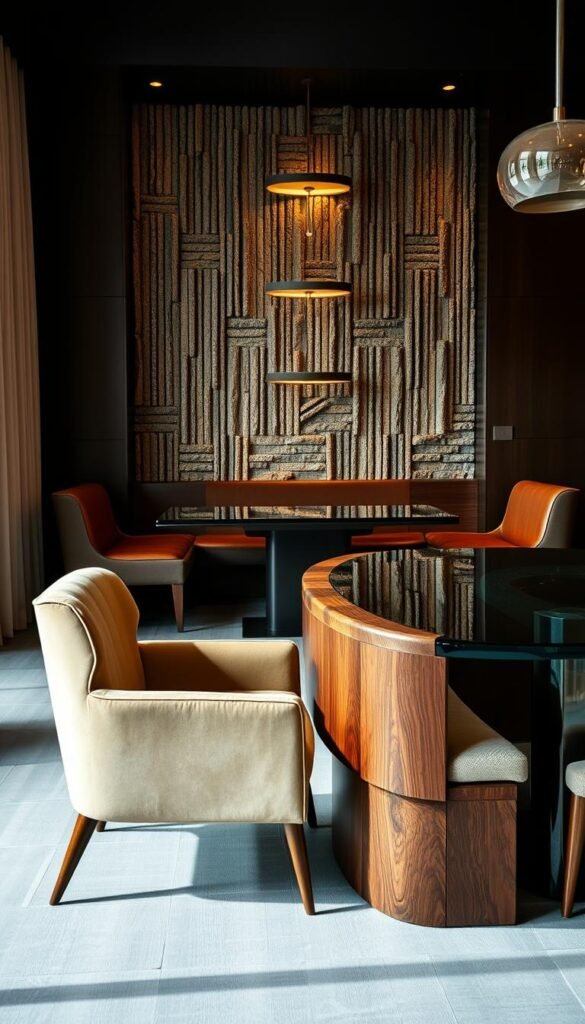
Mix-and-match seating isn’t just trendy—it’s genius-level hosting. Try pairing woven banana leaf chairs with a sleek metal bench. One client uses mismatched thrifted armchairs (each painted the same sage green) around their farm table. “Guests literally fight over which seat to claim,” they laughed. Pro tip: Keep seat heights within 2 inches for comfort.
Three rules for showstopper setups:
- Anchor with one bold piece (like a table with built-in planters)
- Use seating textures to guide the vibe—velvet for luxe, leather for casual
- Leave 24 inches between chair backs and walls for easy movement
Last month, I saw a genius hack: swivel barstools tucked under a counter-height table. By day, it’s a coffee nook. Come party time? Instant extra seats. Remember: great furniture works harder than a caffeine-fueled intern. For more decor ideas that balance form and, check this out.
Your seating choices tell your story. That hand-carved bench from your Bali trip? It’s not just furniture—it’s a conversation starter. I’ve seen clients use everything from vintage theater chairs to repurposed church pews. The key? Make it comfy enough for three-hour party marathons. Because let’s face it—no one remembers the centerpiece if their butt’s asleep by dessert.
Natural Elements: Bringing the Outdoors Inside
There’s something magical about sunlight filtering through leaves while you sip morning coffee—turns out you don’t need a forest for that vibe. Last month, I watched a client transform their boxy house nook using a reclaimed wood table and hanging ferns. Suddenly, their weekday breakfasts felt like brunch at a treehouse café.
Incorporating Wood, Plants, and Natural Light
Let’s start with texture. That knotty wood table isn’t just furniture—it’s a conversation starter about sustainable design. Pair it with sheer curtains that let windows work overtime. I once saw a Brooklyn loft where the owners removed upper cabinet doors to create a view corridor to their rooftop garden. Genius move: your eye travels through the space, making it feel larger.
Plants are your secret weapon. A client’s fiddle-leaf fig became such a star that guests now bring cuttings as host gifts. For low-light areas, try snake plants—they thrive on neglect and add vertical interest. Pro tip: Use varied heights. Stack potted herbs on wood crates under windows for a mini indoor garden.
Three rules for organic balance:
- Let one natural material dominate (like a live-edge table)
- Use reflective surfaces to bounce light deeper into the house
- Add greenery in odd numbers—three planters look intentional
Last week, I visited a house where skylights turned rainstorms into dinner theater. The key? Layered lighting. They used dimmable LEDs to complement—not compete with—nature’s show. Remember: your space should feel like a deep breath, not a jungle expedition. Start with one wood statement piece, then add leafy friends gradually.
Creating a Cozy Ambience with Layers and Warm Lighting
Ever hosted a dinner where the conversation sparkled as much as the candlelight? That’s the power of layered light—it turns basic meals into moody masterpieces. I recently helped a couple transform their sterile eating nook by adding three lighting tiers: a sculptural pendant above their table, wall sconces with linen shades, and tea lights in mercury glass holders. Now their takeout nights feel like date nights.
Here’s the game-changer: your table needs different light types like plants need water. Try pairing a statement chandelier (keep it 30 inches above the surface) with under-cabinet LED strips that graze textured placemats. One client in Portland mixed industrial pendants with fabric drum shades—the combo casts a warm glow on their walnut table while highlighting woven chairs.
Warm bulbs are non-negotiable. Swap harsh 4000K LEDs for 2700K options that mimic sunset hues. Pro tip: Install dimmers on every circuit. A family in Austin uses theirs to transition from bright homework lighting to soft dinner vibes with a slider switch.
Three rules I live by:
- Use upward-facing sconces to bounce light off ceilings
- Hide plug-in puck lights inside glass cabinets to spotlight dishware
- Anchor seating areas with floor lamps that arch over chairs
Last month, I saw a genius hack: Edison bulbs strung above a farmhouse table, paired with LED tape under the buffet. The mix created depth while keeping the chairs bathed in flattering light. Remember: your lighting should work like a favorite playlist—layered, dynamic, and setting just the right mood.
Inspiring DIY and Upcycling Projects for Dining Rooms
What if your thrift store finds could outshine designer pieces? I once helped a client turn a $20 side table into a stunner using leftover tile samples and grout. Their secret? Treating imperfections as character. Let’s explore how home projects can spark big transformations without draining your wallet.
Personalized Touches on a Budget
Your space becomes unforgettable when it carries your fingerprints—literally. Try hand-stenciling fabric runners using freezer paper cutouts. A friend transformed mismatched chairs by painting their legs gold and reupholstering seats with vintage scarves. “Guests always ask where I bought them,” she laughs. The trick? Let existing pieces guide your design choices.
Step-by-Step Creative Projects
Weekend warriors, this one’s for you. Grab those leftover tiles and create a mosaic tray centerpiece:
- Sand a wooden tray’s surface
- Arrange broken tile pieces like puzzle shards
- Secure with adhesive, grout, and seal
Last month, a couple revived their grandma’s hutch by removing doors and adding peel-and-stick wallpaper inside. Now it displays heirloom dishes by day and glows with LED strips at night. Pro tip: Check Facebook Marketplace for free materials—I’ve scored marble samples from countertop shops and fabric swatches from home stagers.
Remember: Great ideas often start with “What if?” That chipped platter? Turn it into a pendant light. Those paint cans? Mix custom colors for drawer liners. Your space should tell your story—one creative hack at a time.
Showcasing Personal Style with Custom Decor Details
Your space should wear your personality like a favorite sweater—comfortable yet unmistakably you. I once helped a couple mix zebra-print chairs with floral drapes, and guess what? It worked because they owned the combo. “People thought we hired a designer,” they laughed. “Nope—just leaned into what makes us happy.”
Pattern Play That Pops
Mixing prints isn’t about rules—it’s rhythm. Designer Corey Damen Jenkins suggests pairing large-scale patterns with tiny repeats. Try stripes on walls with houndstooth napkins, or chevron runners under polka-dot plates. The trick? Keep one color consistent across all elements.
Bold hues need breathing room. A client’s emerald green accent wall shines because it’s balanced by creamy linen chairs and brass hardware. Pro tip: Use the 60-30-10 rule—60% dominant color, 30% secondary, 10% wildcard shades.
Last month, I saw geometric wallpaper meet rustic wood shelves in a loft. The owner added woven baskets for texture, creating depth without clutter. “It’s like my love for math class and camping trips collided,” she joked. That’s the magic of decorating with intention—every layer tells your story.
Start small: recover chair seats in vintage scarves or frame mismatched fabric swatches as art. Your space isn’t a showroom—it’s a living mood board. Let those walls whisper your quirks, one patterned pillow at a time.
Budget-Friendly Tips for a Stylish Dining Room
What if your refresh didn’t require a six-month savings plan? I’ve seen clients transform spaces using thrift-store scores and clever hacks that look straight from a design magazine. Take those mismatched chairs gathering dust—a $15 can of spray paint can unify them into a curated set. One family turned a salvaged door into their table base, topping it with a $40 marble remnant. “Guests assume we hired a pro,” they grinned.
Secondhand gems shine when you know where to look. Check estate sales for solid wood chairs (strip the dated stain!) or Facebook Marketplace for barely-used linens. A client scored 12 linen napkins for $8 at a garage sale—they now double as window valances during parties. Pro tip: Search “vintage restaurant supply” online for commercial-grade finds at yard-sale prices.
Smart storage keeps clutter at bay without cramping style. Try these space-savers:
- Banquettes with lift-up seats hiding holiday dishware
- Floating shelves displaying thrifted pitchers as art
- Table skirts concealing rolling carts for extra serving space
Prioritize where to splurge vs. save. Invest in a quality table (it’s the workhorse), but pair it with $20 marketplace chairs you can refresh. A couple in Denver spent 80% of their budget on a stain-resistant rug, then used $5 yard-sale frames to create a gallery wall. The result? A house that feels luxe without the markup.
Last month, I helped a family stage a party using all secondhand finds. Their secret? Hiding storage in plain sight—a vintage trunk stored extra plates while doubling as a drink station. Remember: great style isn’t about price tags. It’s about seeing potential where others see “used.”
Conclusion
Design isn’t about perfection—it’s about creating spaces that breathe with your story. We’ve explored how designer tricks like layered lighting and multifunctional furniture can turn any area into a magnet for connection. Whether you’re mixing eras or upcycling thrift finds, remember: your choices become the backdrop for life’s best moments.
Take that bold paint sample collecting dust in your drawer. Pair it with textured linens hiding in your closet. I once watched a client transform her breakfast nook using leftover tile samples as coasters—now her morning coffee tastes like a boutique experience. That’s the magic of making ideas your own.
Your space should evolve like a favorite playlist. Maybe start with one sculptural chair that makes you smile, then build around it. Those brass sconces you scored online? Let them become part of your daily rhythm, casting warm light on Tuesday leftovers and Saturday charcuterie boards alike.
Here’s the secret sauce: treat your gathering zone as a living experiment. Swap out centerpieces with the seasons. Rotate art pieces when moods shift. The most memorable spaces aren’t designed—they’re curated, one creative way at a time. Now go turn those sparks of inspiration into flames.
